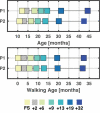Development of running is not related to time since onset of independent walking, a longitudinal case study
- PMID: 36875237
- PMCID: PMC9978154
- DOI: 10.3389/fnhum.2023.1101432
Development of running is not related to time since onset of independent walking, a longitudinal case study
Abstract
Introduction: Children start to run after they master walking. How running develops, however, is largely unknown.
Methods: We assessed the maturity of running pattern in two very young, typically developing children in a longitudinal design spanning about three years. Leg and trunk 3D kinematics and electromyography collected in six recording sessions, with more than a hundred strides each, entered our analysis. We recorded walking during the first session (the session of the first independent steps of the two toddlers at the age of 11.9 and 10.6 months) and fast walking or running for the subsequent sessions. More than 100 kinematic and neuromuscular parameters were determined for each session and stride. The equivalent data of five young adults served to define mature running. After dimensionality reduction using principal component analysis, hierarchical cluster analysis based on the average pairwise correlation distance to the adult running cluster served as a measure for maturity of the running pattern.
Results: Both children developed running. Yet, in one of them the running pattern did not reach maturity whereas in the other it did. As expected, mature running appeared in later sessions (>13 months after the onset of independent walking). Interestingly, mature running alternated with episodes of immature running within sessions. Our clustering approach separated them.
Discussion: An additional analysis of the accompanying muscle synergies revealed that the participant who did not reach mature running had more differences in muscle contraction when compared to adults than the other. One may speculate that this difference in muscle activity may have caused the difference in running pattern.
Keywords: children; clustering; development; kinematics; muscle synergies; neuromuscular control; running.
Copyright © 2023 Bach, Zandvoort, Cappellini, Ivanenko, Lacquaniti, Daffertshofer and Dominici.
Conflict of interest statement
The authors declare that the research was conducted in the absence of any commercial or financial relationships that could be construed as a potential conflict of interest.
Figures






Similar articles
-
Contributions to the understanding of gait control.Dan Med J. 2014 Apr;61(4):B4823. Dan Med J. 2014. PMID: 24814597 Review.
-
Muscle Synergies in Children Walking and Running on a Treadmill.Front Hum Neurosci. 2021 May 10;15:637157. doi: 10.3389/fnhum.2021.637157. eCollection 2021. Front Hum Neurosci. 2021. PMID: 34040508 Free PMC article.
-
The development of mature gait patterns in children during walking and running.Eur J Appl Physiol. 2021 Apr;121(4):1073-1085. doi: 10.1007/s00421-020-04592-2. Epub 2021 Jan 13. Eur J Appl Physiol. 2021. PMID: 33439307 Free PMC article.
-
Body Weight Control Is a Key Element of Motor Control for Toddlers' Walking.Front Netw Physiol. 2022 Mar 24;2:844607. doi: 10.3389/fnetp.2022.844607. eCollection 2022. Front Netw Physiol. 2022. PMID: 36926099 Free PMC article.
-
Effect of Strength Training on Biomechanical and Neuromuscular Variables in Distance Runners: A Systematic Review and Meta-Analysis.Sports Med. 2020 Jan;50(1):133-150. doi: 10.1007/s40279-019-01184-9. Sports Med. 2020. PMID: 31541409
References
-
- Bekius A., Bach M. M., van de Pol L. A., Harlaar J., Daffertshofer A., Dominici N., et al. (2021). Early development of locomotor patterns and motor control in very young children at high risk of cerebral palsy, a longitudinal case series. Front. Hum. Neurosci. 15:659415. 10.3389/fnhum.2021.659415 - DOI - PMC - PubMed
LinkOut - more resources
Full Text Sources
Research Materials

